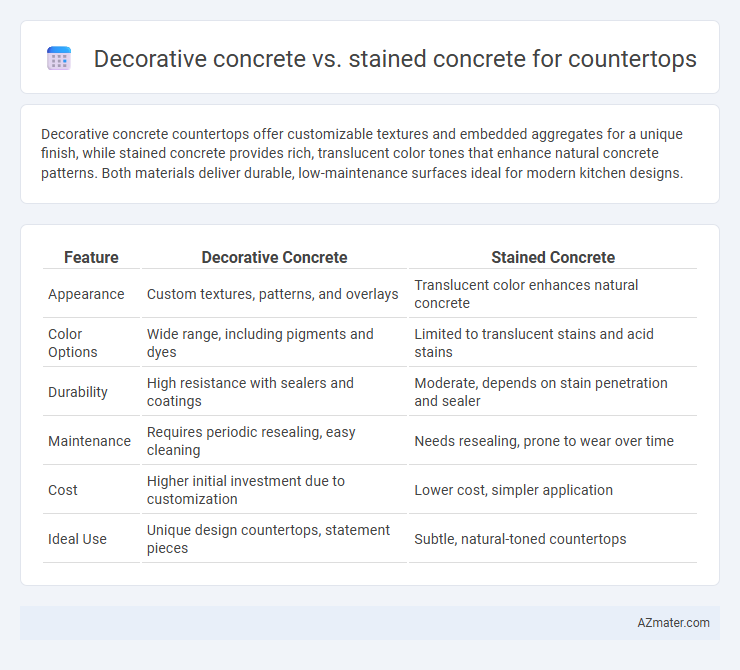Decorative concrete countertops offer customizable textures and embedded aggregates for a unique finish, while stained concrete provides rich, translucent color tones that enhance natural concrete patterns. Both materials deliver durable, low-maintenance surfaces ideal for modern kitchen designs.
Table of Comparison
| Feature | Decorative Concrete | Stained Concrete |
|---|---|---|
| Appearance | Custom textures, patterns, and overlays | Translucent color enhances natural concrete |
| Color Options | Wide range, including pigments and dyes | Limited to translucent stains and acid stains |
| Durability | High resistance with sealers and coatings | Moderate, depends on stain penetration and sealer |
| Maintenance | Requires periodic resealing, easy cleaning | Needs resealing, prone to wear over time |
| Cost | Higher initial investment due to customization | Lower cost, simpler application |
| Ideal Use | Unique design countertops, statement pieces | Subtle, natural-toned countertops |
Overview: Decorative vs Stained Concrete Countertops
Decorative concrete countertops offer a customizable finish with textures, embedded materials, and patterns, making each piece unique and visually striking. Stained concrete countertops highlight the natural concrete surface with translucent color treatments that enhance depth and variation without altering texture. Both options provide durable, low-maintenance surfaces ideal for modern kitchens, but decorative concrete emphasizes artistic design while stained concrete focuses on subtle color enhancement.
Appearance and Design Options
Decorative concrete countertops offer extensive versatility in texture, pattern, and color customization, enabling unique finishes such as polished, stamped, or exposed aggregate surfaces that mimic natural stone or other materials. Stained concrete countertops, on the other hand, emphasize rich, translucent color effects that penetrate the concrete for a variegated, marbled appearance with options like acid-based or water-based stains enhancing depth and character. Both methods provide durable, low-maintenance surfaces but differ in aesthetic focus--decorative concrete prioritizes texture and sculptural detail, while stained concrete excels in dynamic color variation and visual warmth.
Durability and Longevity
Decorative concrete countertops offer superior durability due to their dense composition and ability to withstand heavy use without chipping or cracking. Stained concrete, while visually appealing with its color variations, may require periodic resealing to maintain its longevity and resist surface wear. Both options provide lasting performance, but decorative concrete typically delivers enhanced resistance to stains, scratches, and heat over time.
Cost Comparison
Decorative concrete countertops generally cost between $70 and $135 per square foot, offering versatile design options and higher customization, while stained concrete countertops typically range from $50 to $90 per square foot, making them a more budget-friendly alternative. Stained concrete involves applying acid-based stains or water-based stains to existing concrete, minimizing material expenses and labor time compared to decorative concrete, which often requires intricate stamping, polishing, or coloring techniques. When considering long-term investment, decorative concrete may have higher upfront costs but can add more significant aesthetic value and durability, whereas stained concrete provides an economical yet visually appealing solution.
Installation Process Differences
Decorative concrete countertops often require intricate formwork and custom molds to achieve textured or embedded designs, making the installation process more labor-intensive and time-consuming. Stained concrete countertops involve applying acid-based or water-based stains directly onto a smooth, cured surface, which demands precise surface preparation and multiple sealing layers to ensure color durability and a polished finish. Both methods require skilled craftsmanship, but decorative concrete typically involves more complex shaping, while stained concrete emphasizes surface treatment and finishing techniques.
Maintenance Requirements
Decorative concrete countertops require regular sealing to prevent staining and moisture damage, with resealing recommended every 1-3 years depending on use. Stained concrete countertops also need sealing but often demand more frequent maintenance to preserve color vibrancy and resist fading caused by UV exposure. Both options benefit from using gentle cleansers and avoiding abrasive materials to maintain their aesthetic appeal and durability over time.
Customization Potential
Decorative concrete countertops offer extensive customization potential through various techniques such as stamping, engraving, and embedding materials, allowing for unique textures and visual effects tailored to individual styles. Stained concrete, while providing rich color variations through acid or water-based stains, delivers a more limited design scope primarily focused on achieving translucent, variegated hues rather than intricate patterns. Both options can be combined with sealers and finishes to enhance durability and appearance, but decorative concrete provides broader creative freedom for personalized countertop designs.
Surface Texture and Finishes
Decorative concrete countertops offer a diverse range of surface textures including smooth, polished, exposed aggregate, and stamped patterns, providing a versatile aesthetic tailored to various design preferences. Stained concrete countertops primarily focus on color enhancement through acid or water-based stains while maintaining a smooth or satin finish, emphasizing depth and richness in the concrete's natural texture. Both options can be sealed for durability, but decorative concrete excels in customizable surface textures, whereas stained concrete highlights subtle color variations within a more uniform finish.
Pros and Cons of Each Option
Decorative concrete countertops offer versatility in design with options like stamped patterns and embedded aggregates, providing durability and a unique aesthetic but require sealing to prevent stains and are prone to cracking over time. Stained concrete countertops deliver rich, translucent color effects that enhance natural concrete textures, offering a cost-effective alternative to other materials, but may show wear more easily and require periodic resealing to maintain vibrancy. Choosing between decorative and stained concrete depends on the desired visual impact, maintenance commitment, and resistance to everyday kitchen use.
Best Applications and Recommendations
Decorative concrete countertops offer a versatile solution for high-traffic kitchen environments due to their durability and customizable textures, making them ideal for modern and industrial design themes. Stained concrete is best applied in settings prioritizing color depth and artistic finishes, complementing contemporary and rustic aesthetics with its rich, translucent tones that enhance natural stone patterns. For optimal results, select decorative concrete for heavy-use areas requiring strong resistance to wear, while stained concrete suits spaces where visual appeal and subtle color variations are desired.

Infographic: Decorative concrete vs Stained concrete for Countertop
 azmater.com
azmater.com